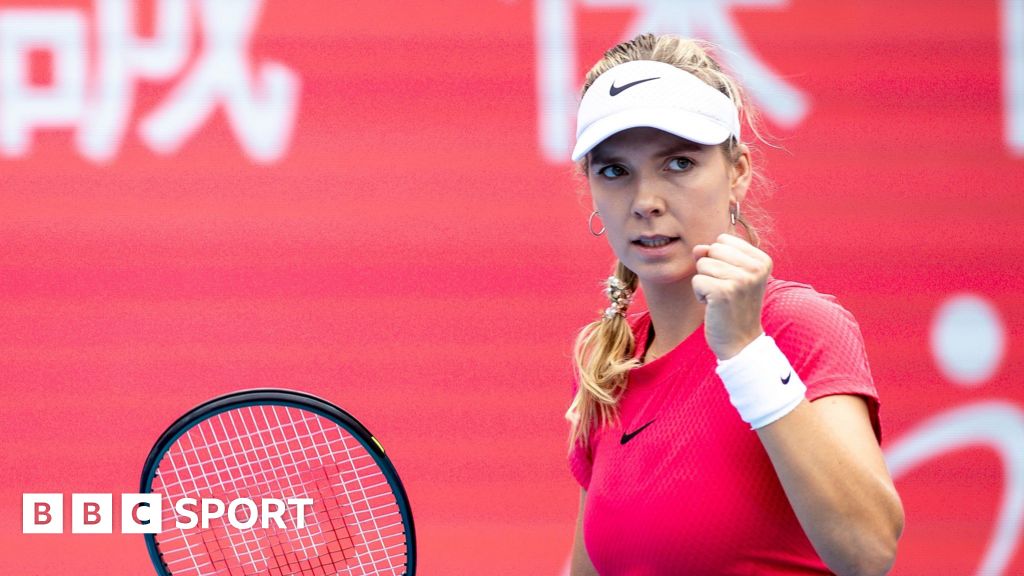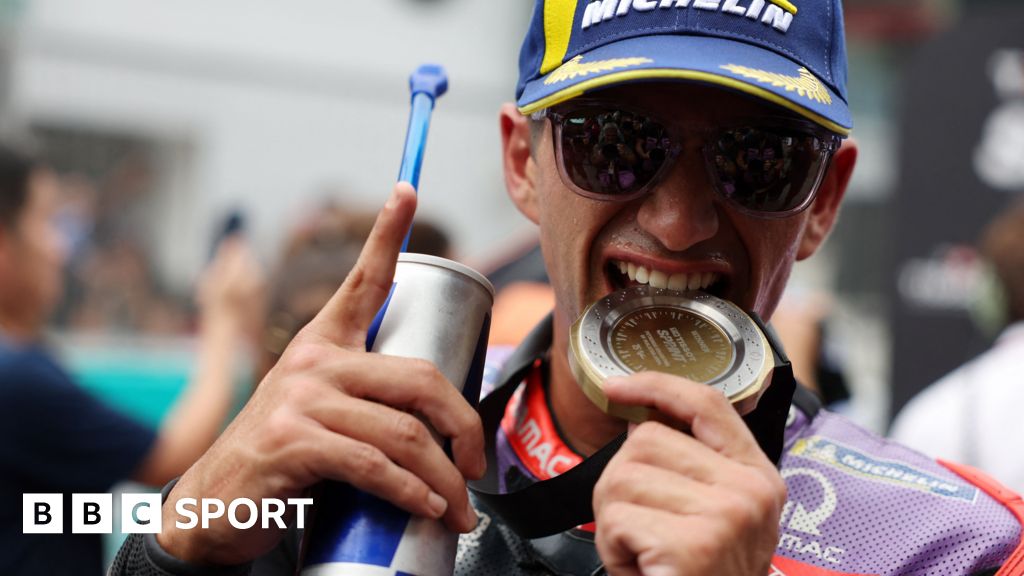ARTICLE AD BOX
 Image source, Getty Images
Image source, Getty Images
In nine completed seasons of Formula E, eight different drivers have won the drivers' championship
Lorraine McKenna and Andrew Benson
BBC Sport
"Drive The Future".
That was the tagline when motorsport's governing body, the FIA, launched Formula E in 2014 - a new racing series that was at the forefront of the electric revolution.
The championship aimed to muscle in on the landscape that the internal combustion engine has dominated, introducing a younger audience to a more sustainable competition while showcasing the potential of battery-powered cars.
In 2015, Sir Richard Branson, who was a backer of one of the original 10 teams, Virgin Racing - now known as Envision Racing - felt Formula E would be more popular than Formula 1 within five years.
A decade on from the sport's debut, and with the 10th season about to reach a conclusion with a double-header in London this weekend, how far has it come?
"A lot of people know now that 'electric Formula 1' is Formula E," Brazilian Lucas di Grassi, who won the drivers' championship in season three, tells BBC Sport.
"The championship was a start-up; now it’s a consolidated, multi-continent, multi-national, multi-manufacturer series that still has a lot to improve, but has grown massively from the start."
The idea for an all-electric street circuit championship was scribbled down on a napkin at a Paris restaurant in 2011 by founder Alejandro Agag and former FIA president Jean Todt.
While the focus was very much on environmental sustainability during its inaugural season, Formula E chief executive officer Jeff Dodds believes the sport's core values have evolved since then.
"I would say now that's broadened out to be more social and environmental sustainability," Dodds tells BBC Sport. "So you'll see us focusing more on a lasting legacy where we race."
Is free-to-air coverage important for Formula E?
In any sport, broadcast is king. Getting a major channel to be the home of what organisers are trying to market to the fans - and the sponsors - is a key piece of the growth puzzle.
The BBC, ITV, Channel 4 and Channel 5 have all taken turns at hosting the series on terrestrial television. In December 2023, Formula E announced a deal with TNT Sports in the search for a permanent residence, placing season 10 behind the paywall in the UK. However, the London finale will be free-to-air in the UK on Quest.
Not increasing the audience is the "biggest problem" the sport has, suggests McLaren Racing chief executive Zak Brown.
"Definitely more free-to-air," he says, pointing to how that might change. "Right now, the fanbase isn’t big enough to… trend fans are not going to stumble across it. That's what it needs to work on."
Dodds cites the investment TNT Sports has made into the on-screen production of Formula E, along with deals that have been done with big broadcasters in countries like China, Japan and India - places the sport currently races in. But in its eagerness at the start to build a following, bouncing around UK TV channels was more of a hindrance than a help.
"You don't want anybody in any of our prime markets asking the question, 'where can I watch it?' That's a pretty bad outcome for a sport. So that's a problem that we have to solve in a long-term way," says Dodds.
Following the season opener in Mexico in January, Formula E announced that TV audiences in the UK had increased by 29% on the previous campaign's opening viewing figures.
"It has the framework to be successful, but to turn the corner to really be commercially successful it needs to have a more consistent and better calendar and more consistent and better television," Brown says.
'Motorsport is a laboratory for technologies'
Image source, Getty Images
Image caption,Lucas di Grassi has competed in Formula E since the very beginning and is tied with fellow driver Sebastien Buemi for most wins in the sport with 13 victories
The lure of electrical innovation was still a long way off for ordinary road users when Formula E arrived on the scene 10 years ago.
"Back then, anybody who talked about electric cars were either crazy or green activists," says ABT Cupra driver Di Grassi.
As of the end of June 2024, there are more than 1.145 million fully electric cars on UK roads.
When the series started, all teams were given the same Spark-Renault SRT 01E car, with F1 giants McLaren and Williams involved in developing the electric motors and batteries.
However, an early drawback was 'range anxiety', or the battery's relatively short life. When a driver came into the pits during an E-Prix, for example, instead of changing tyres, they would have to jump out and swap over to a new, fully charged car.
"I think the technology continues to develop at a fast pace, no different from mobile phones: used to be a brick, now it’s on your wrist. The same trajectory of battery technology," says McLaren chief Brown.
Another hurdle the sport had to navigate in its pursuit of new fans was speed. The first generation of car reached a top speed of 140mph - a long way off the 186mph reach of an F1 car in 2014.
The second model saw speeds increased to around 173mph - and mid-race swaps were dumped.
Now the current iteration, the 'gen 3' car, has upped the ante to 200mph thanks to a new front powertrain and faster charging capabilities.
"A great part of motorsport survives because motorsport is a laboratory for technologies," says Di Grassi.
While the sport has consistently pushed the boundaries of electric racing, Di Grassi feels a Formula E car has the potential to go even quicker.
"Having a fast and a performing car is very important for the public perception towards how they appreciate the sport," Di Grassi adds. "So for me, yes, with the performance of the car, there is a direct correlation to engaging the fans."
'Producing electric cars and entering Formula E is logical step'
Image source, Getty Images
Image caption,Every team used the same specification of car during the inaugural Formula E season (above) before teams were allowed to develop new power trains, gearbox cooling system from season two
From the outset, Formula E aimed to attract the best drivers and motorsport manufacturers.
British manufacturer Jaguar made a return to competitive racing for the first time in 12 years in season three, while titans Audi, BMW and Mercedes entered the championship to a huge fanfare, with the Mercedes-EQ team winning back-to-back driver and team titles in the 2020-21 and 2021-22 seasons.
However, the three German marques had all departed the series by the start of the 2022-23 campaign to concentrate on other projects, leaving questions lingering as to whether the sport could truly reach the heights of the F1 juggernaut.
Like Jaguar, Porsche came out of an even longer single-seater racing hibernation - 30 years to be exact - to join Formula E five years ago. The Stuttgart-based manufacturer has committed to the sport until 2030 - so why has Porsche stuck around when its German rivals have long said goodbye?
"If racing is in your DNA, like Porsche, and you're going to be producing only electric cars, then it's perfectly logical to race in a world championship that's electric," says Dodds. "So, there are some people that are in it for their culture, for their DNA."
Formula E heads into a new era from 2026 with the 'gen 4' upgrade already in development for season 13 and beyond. As well as Porsche, Nissan and Jaguar have also put pen to paper to remain in the series.
When Mercedes withdrew from Formula E, McLaren Racing stepped in to acquire the world champions and enter themselves.
Brown says "sustainability" was a big factor. "We take that very seriously," he adds.
"It's like why we're in America. F1 is really big in America but IndyCar gives us icing on the cake. Sustainability, doing great in F1, very important to us; Formula E gives us another icing on the cake."

 3 months ago
24
3 months ago
24








 English (US)
English (US)